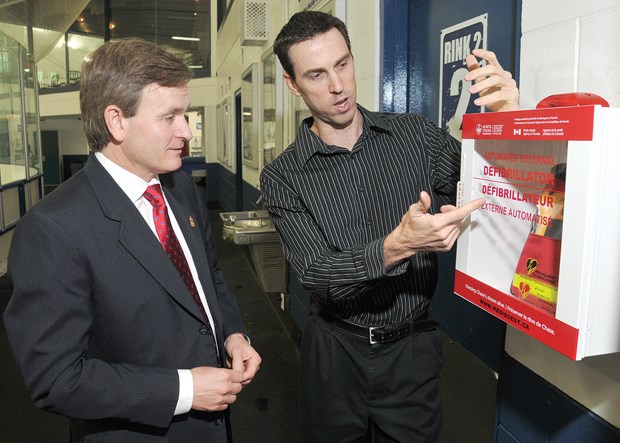When a man collapsed near the SeaBus station in North Vancouver recently, bystanders scrambled to find a defibrillator while waiting for paramedics to arrive on scene, but in the end could not track one down.
The incident prompted a renewed call by the Heart and Stroke Foundation to have Automated External Defibrillators (AEDs) available in places frequented by large groups of people, including the SeaBus station.
But according to TransLink spokesperson Jiana Ling, neither the SeaBus nor the terminal where it docks have a defibrillator because staff is not trained to operate one.
While all staff have to complete their level one first aid requirements, "to operate one of those (AEDs), you need to have a higher level of training for first aid," she said.
Ling said in case of a major medical emergency, staff are told to contact 9-1-1. "When it really becomes that serious, you would really want someone who's properly trained to take over and assist with medical conditions to make sure it doesn't make it worse," she added. "I think it requires a lot more than bringing in that equipment. It also requires training all the staff and making sure that everyone knows how to operate that."
But the Heart and Stroke Foundation's Shelley Parker says anyone can use an AED because the machine prompts the user on what to do.
In fact, Parker - resuscitation program manager for B.C. and Yukon - said transit terminals that large numbers of people are moving through are ideal spots for public access to AEDs.
"AEDs are so intuitive, if you can figure out how to press the on button, which is very easy, the machine talks to you and guides you through all the steps you need to do."
Parker also noted that the Canada Line has AEDs available at most locations. Costs start around $1,400 each. On July 25, North Vancouver MP Andrew Saxton announced three new AEDs would be installed at the Canlan Ice Sports North Shore arena in a partnership between the federal government and the Heart and Stroke Foundation.
The foundation also partners with the province and B.C. Emergency Health Services to implement the B.C. Public Access to Defibrillators Program by making AEDs available and providing support for the devices.
Gord Kirk, interim director of dispatch operations with the B.C. Ambulance Service, said dispatchers will ask bystanders who call 9-1-1 for an ambulance if a B.C. PAD program AED is available nearby. B.C. Emergency Health Services is working to expand the dispatch registry to include AEDs that are not part of the program.
"Ambulance paramedics respond to 2,400 to 2,800 sudden cardiac arrest calls every year, "said Kirk in an email to the North Shore News. Heart attacks are a leading cause of death among adults in B.C. "This could be someone's father, mother, husband, wife, son or daughter, friend or loved one," he said.
"Evidence shows that survival rates from a sudden cardiac arrest can be increased by up to 75 per cent if a defibrillator is used within five minutes."
Kirk said the program expects to have 750 AEDs donated to various public spaces, such as parks, senior centres and recreation centres by 2017.
BC PAD program AEDs can be found on the North Shore at the following locations: n North Shore Neighbourhood House n North Vancouver City
Libraryn Lynn Canyon Park and Ecology Centre n North Vancouver District Public Library n Northlands Golf Course n Gleneagle Golf Course n Ambleside Par 3 n Rutledge Field There are other AEDs available along the North Shore that were purchased through other initiatives.



